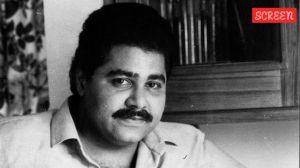THE YOUNG BOY AND THE SEA
Our correspondent explores the water world of prodigies who battle at the deep end, chasing records in a country with a shallow swimming tradition

Much before professional concerns consume you like thousand other routines with which travellers from Pune to Mumbai reduce the picturesque Lonavala to a passing blur or a half-way milestone, this unique westward inter-city trip is all about the excitement of reaching out to the seas.
For a first-timer like Kaustubh Vemuri two Octobers ago, travelling from the land-locked city to the oceanic expanse off Gateway — where he was to undertake his maiden sea-swim — it was also about leaving the restraining confines of a local pool and setting free his paddle-strokes.
A record declaring him the youngest to swim to the destination Dharamtar jetty, came along next. Though there was neither a podium to climb up on, nor beaten rivals to cheekily console.
Was the 71-km long, lonely effort then worth the strain and the few fish-bites for a boy of a mere 8?
Medals won by competing in taped pool-lanes are more mainstream — recognised and revered. But channel crossing — a fast-gaining obsession among parents pushing their wards to beat the high waves, bigger whales and more insistently, a prior-achiever’s age in months-and-years — is emerging as a child-swimmer’s chore.
Typical of young India’s fixation with younger prodigies, these many sea-swims across myriad gulfs and straits around the world have thrown up no serious competitive swimmers of note. Two decades have lapsed since Khazan Singh brought home India’s biggest prize — the 1986 Seoul Asiad silver. A barren cabinet thereafter makes it clear that parents’ and coaches’ continued encouragement for children to swim across oceans means the phrase ‘missing the wood for the trees’ is easily appropriated to ‘skipping the pool for the seas.’
Drawing parallels with marathon boy Budhia’s training tribulations would be bordering on perennial skepticism about parents’ intentions. There are no medical limits set down in rules to stop children from attempting the swims, though some channel-crossing associations have put an age-bar of 14 or 16.
“You can never tell the limits of endurance,” opens Dr Reena Gollapudy — Vemuri’s mother — herself a biologist. “I’ve never exerted him thoughtlessly. I won’t put him in the sea if he’s not comfortable,” she adds. Vemuri who recently completed the Santa Barbara Channel, off California to become the youngest Asian to do so and has earlier set an age-record for the Toroneos Gulf, Aegean Sea, Greece besides the Arabian Sea endeavour, is now aiming for the Cook Strait, New Zealand and later a South African swim expedition to complete the five continents. He is on schedule to come out the youngest in managing all those. But struggling with funds — he has already spent around 13 lakh, he has realised that India cares more about the five-ringed Olympic medal.
The second athlete to avail of the Mittal Champions Trust kitty after Joshna Chinappa two years ago, Vemuri couldn’t renew the contract to beyond one year (though he swam Greece in that period), and was soon overtaken by Beijing qualifier sprinter Veerdhaval Khade. “Can’t blame them, Khade was a bigger sensation,” says his mother, who is keen that her son — now 10 years 11 months — continues to train and makes the competitive switch to Olympics’ latest-entrant 10 km swim-marathon in the coming years.
But the swimming federation dismisses it all as publicity gimmicks. “All these are individual feats, and it is difficult to monitor them. Besides, we cannot support anyone who is under the prescribed 14 years,” says Swimming Federation of India secretary Virendra Nanavati. Not averse to helping out a youngster who joins the competitive mainstream, Nanavati adds: “They should adopt the right track of entering national competitions so we can select them.”
But India — still living with Mihir Sen’s English Channel hangover — has a flair for the long-distance, with pre-teens tasting sea waters in mini-trunks. But Bula Chowdhury — who has ruled the oceans with her multiple channel-crossing efforts and is still going strong at 37 — says the cold waters which can lead to hypothermia and even sea-life which is tricky to deal with, can cause a lot of physical and mental stress among children.
“I won’t recommend anyone below 14 to venture into high seas,” she says. “I moved from short-course to long-distance and back, and then back again, but it was very difficult,” adds the swim-champion who in 2004 became the first woman in the world to conquer seven seas across five continents. At 9 though, she was also setting marks in competitive school events. “I had to keep adding and losing weight to adjust since body fat is necessary in the seas,” she says. “But a 10 or 11-year-old is more flexible mentally and it’s easier switching then.”
Chowdhury’s longevity might have something to do with the recognition she is accorded, but for Khazan Singh, who won the the 200 m butterfly silver, the stagnation in sprint-swimming is getting worrisome. “Agreed the world competition is unimaginably tough, but there is no harm in picking youngsters early,” he says.
Singh’s reservations on the issue of promoting long-distance swimming are more practical. “Where is the security on the beaches to train?” he demands. “You need to determine early whether a swimmer has the body-type — the long muscles — to make it big and even specialise in one stroke. Our sports medicine backup, too, is lacking.”
But he does admit that competitive swimming is the real one. “It’s good that these children are prepared to swim in any place in far off countries, and adjust. But a race environment has real value,” he says.
Efforts are on — again by Mittal Champions Trust — to set up a programme for young swimmers in Australia, and co-ordinator Manisha Malhotra insists that swimmers like Vemuri are still in the loop. “We are trying to work something out, and with 10 km’s inclusion in the Olympics, we’ll look into formal training for the long-term.”
This is what excites even Vemuri’s coach Vinay Marathe. “The 10 km is an opening for all long-distance open water race aspirants and the faster the federation sees it as an opportunity, the better,” he says.
“The scene is quite foggy and children are best advised to come into the competitive fold rather than blindly pursuing sea-records,” says Mumbai’s coach and administrator Pradeep Divgikar, who though not quite wary of a Budhia-like catch in swimming, is still cautious about subjecting children to the rough and tumble of ocean waters. “Someone like Anita Sood or even Mayur Mehta were good at both, and those should be the examples to follow,” he adds.
For the boy gunning for the five oceans life is more simplistic, though his daily schedules — at times 500 laps of the pool — look terribly strenuous. “It’s an adventure with all the blue whales and seals and waves,” says Vemuri. The 10-year-old’s next destination Cook Straits — his toughest swim yet — are something that “James Cook discovered.” Thrown to the sharks, Vemuri’s spirit remains unscathed — but it’s the still waters in highly-competitive pools which are known to break even the sturdiest.



- 01
- 02
- 03
- 04
- 05



























